Brain food: The blank canvas problem
It's been a number of weeks of silence, so welcome back to brain food. These aim to be short and easy to digest pieces that enrich your work and life with simple ideas and principles.
It is so fine and yet so terrible to stand in front of a blank canvas
- Paul Cezanne, 20th century French artist
▓▓▓▓▓▓░░░░░░░░░
2023 year progress: 42% complete
The blank canvas problem
A blank canvas is vessel for expressive artwork, insightful knowledge, innovative solutions, and anything that our minds can imagine. We fill canvases as unique individuals and diverse teams. We use canvases to strive towards our goals, and the picture is always influenced by everything around us and the world's impact on our mental modals. More often than not, we're crippled when staring at a blank canvas. We have an intention but lack action. We don't know where to start- whether we're creating content, building a project, leading people, or even figuring out ways to achieve our personal goals.
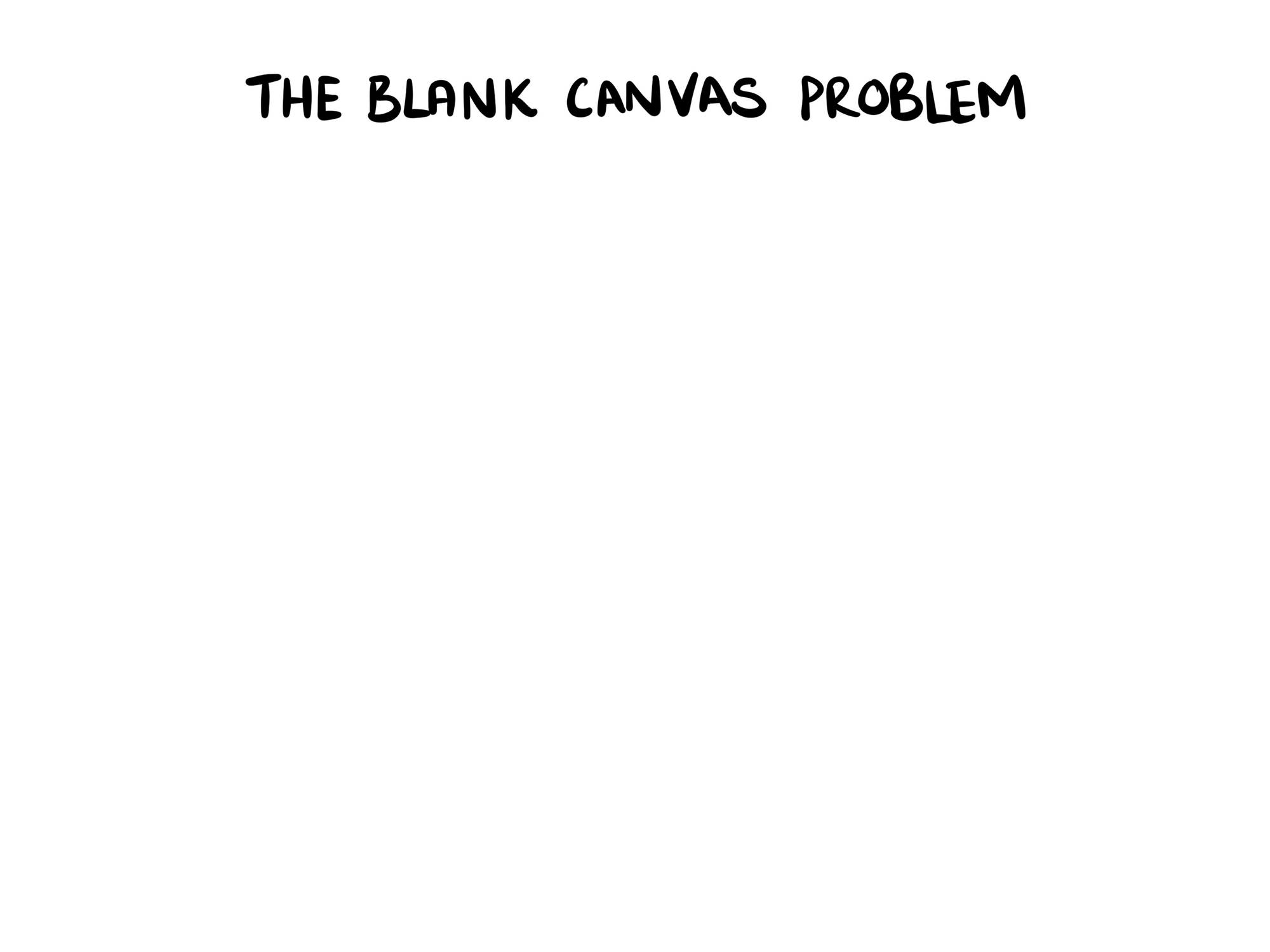
How can we relieve the anxiety, get things done, and conquer the blank canvas problem? Let's explore three approaches - many I've used to write this very article.
1. Describe the thing and embrace imperfection
The root of the problem when staring at a blank canvas is the torrent of thoughts that fill out heads. Ideas, possibilities, and concerns create a mental roadblock to making progress. We're both full of ideas, but also crippled by choice without structure.
Describe the thing: We often overlook the importance of simply writing down the thing we're trying to do.
- "Writing about the blank canvas problem"
- "Solving the strange team dynamic that's emerged"
- "Planning the tasks to deliver the project ahead"
- "Fixing the peculiar bug that cropped up in the app"
At face-value, these might look redundant because they're so simple. But writing the problem statement and articulating it clearly helps us think better about it. After writing it down, and staring at it, we might adjust the problem statement based on our own thinking or collaborative input. The previous examples might morph into:
- "Writing about the blank canvas problem"
→ "Articulating the blank canvas problem and describing ways to overcome" - "Solving the strange team dynamic that's emerged"
→ "Understanding the areas of the team dynamic that's hindering our goal" - "Planning the tasks to deliver the project ahead"
→ "Outlying the value the project provides and prioritising tasks to achieve it" - "Fixing the inconsistent peculiar bug that cropped up in the app"
→ "Diagnosing the cause of the peculiar bug, and what causes it"
Your problem statement grounds your mindset and forces you to filter out the noise. It might take many iterations, but it's important to not obsess over tiny details. Let the thinking flow - an unideal problem statement can be refined later after more thinking has unravelled. Its job is to point you in a good enough direction.
2. Generate a diversity of ideas
Ideas are like the phases of matter. Thinking about ideas = vapour, speaking about ideas = liquid, and putting ideas down on paper = solid.
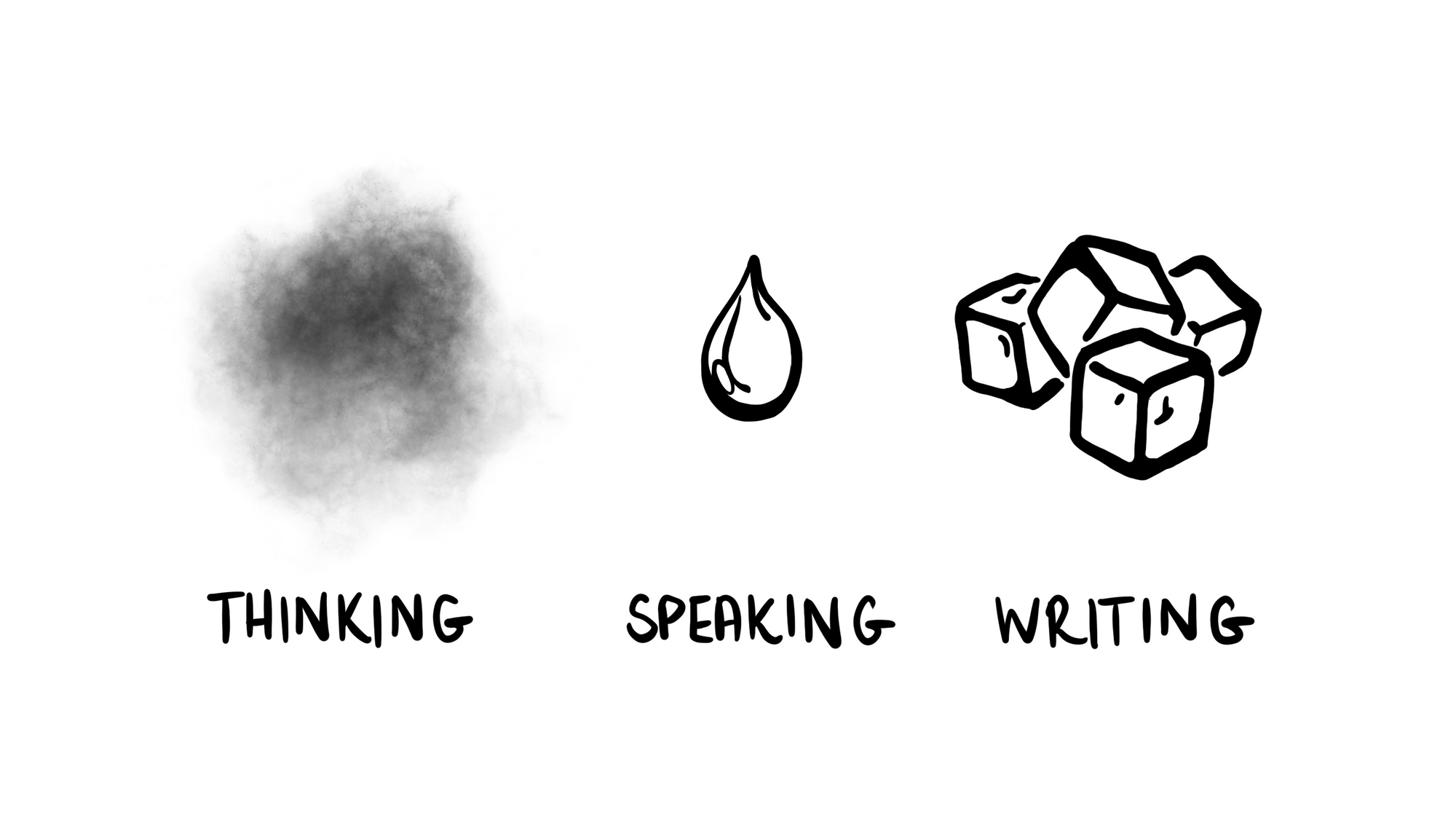
Thinking exclusively about the problem statement will generate a diversity of ideas whether you do it alone or collaboratively in a group. The goal here is to brain dump thoughts and possibilities that will more or less completely encompass the problem statement. We should walk away feeling a sense of ease that our vapour thoughts have been solidified into something tangible.
Crazy 8's
If your problem statement is vague, go for quantity rather than quality of ideas. Crazy 8's is a technique where we write down or sketch eight crazy ideas related to the problem statement. These could be concepts related to the problem statement, topics that need to be investigated, or even more specific problems. The ideas can be as farfetched as you like. In a group setting, generating these, then voting later is an excellent way to go from blank canvas → many ideas → most promising ideas.
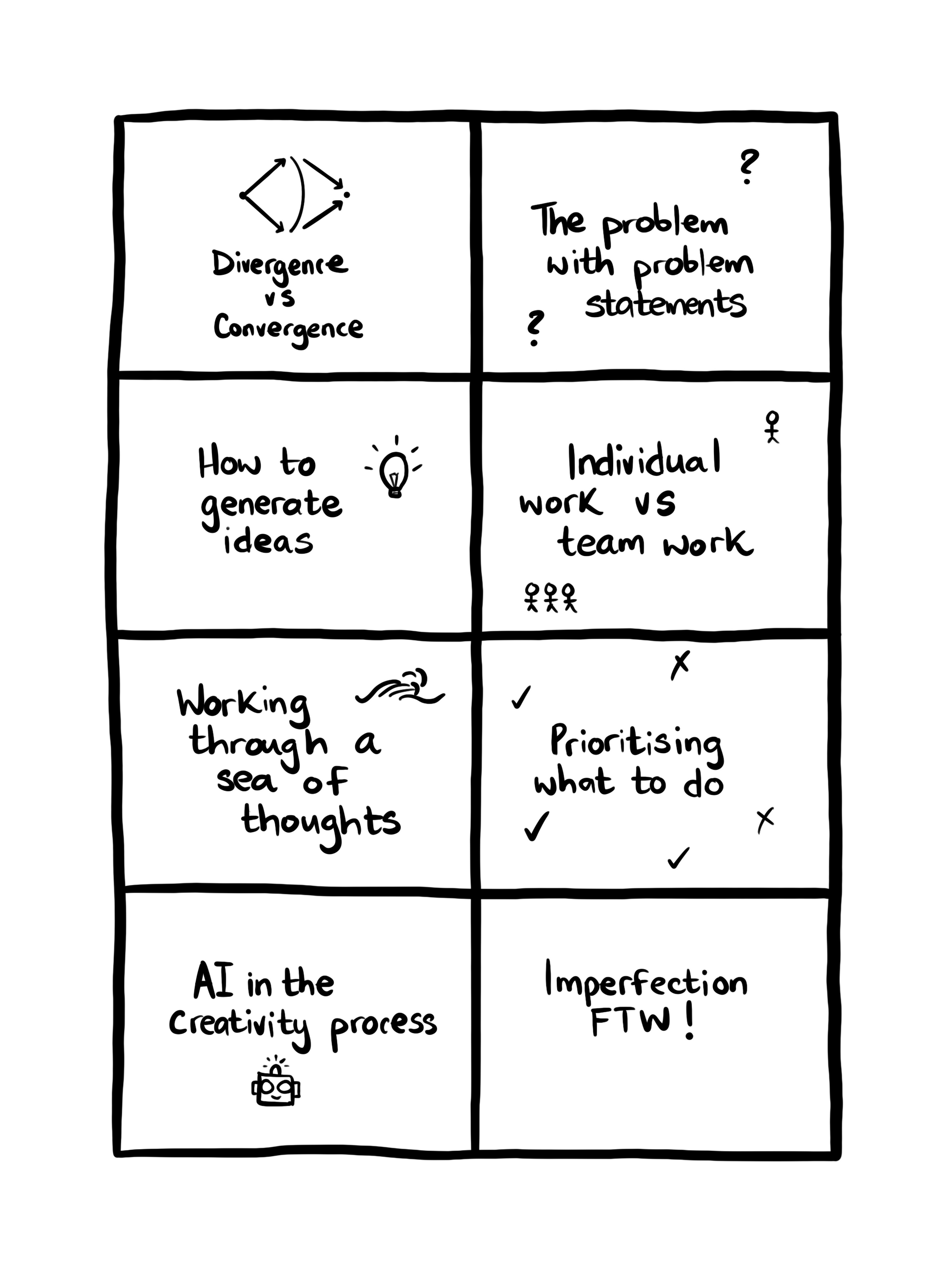
Storyboarding
If your problem statement is specific enough, quality in the thought process might be important. Storyboarding is a technique where we describe a journey surrounding the problem statement in a logical way. This storyboard can be annotated with points of importance, questions that crop up, or gaps that need to be filled. In collaborative settings, having each person generate an independent storyboard then comparing highlights different perspectives and creates a more complete picture.
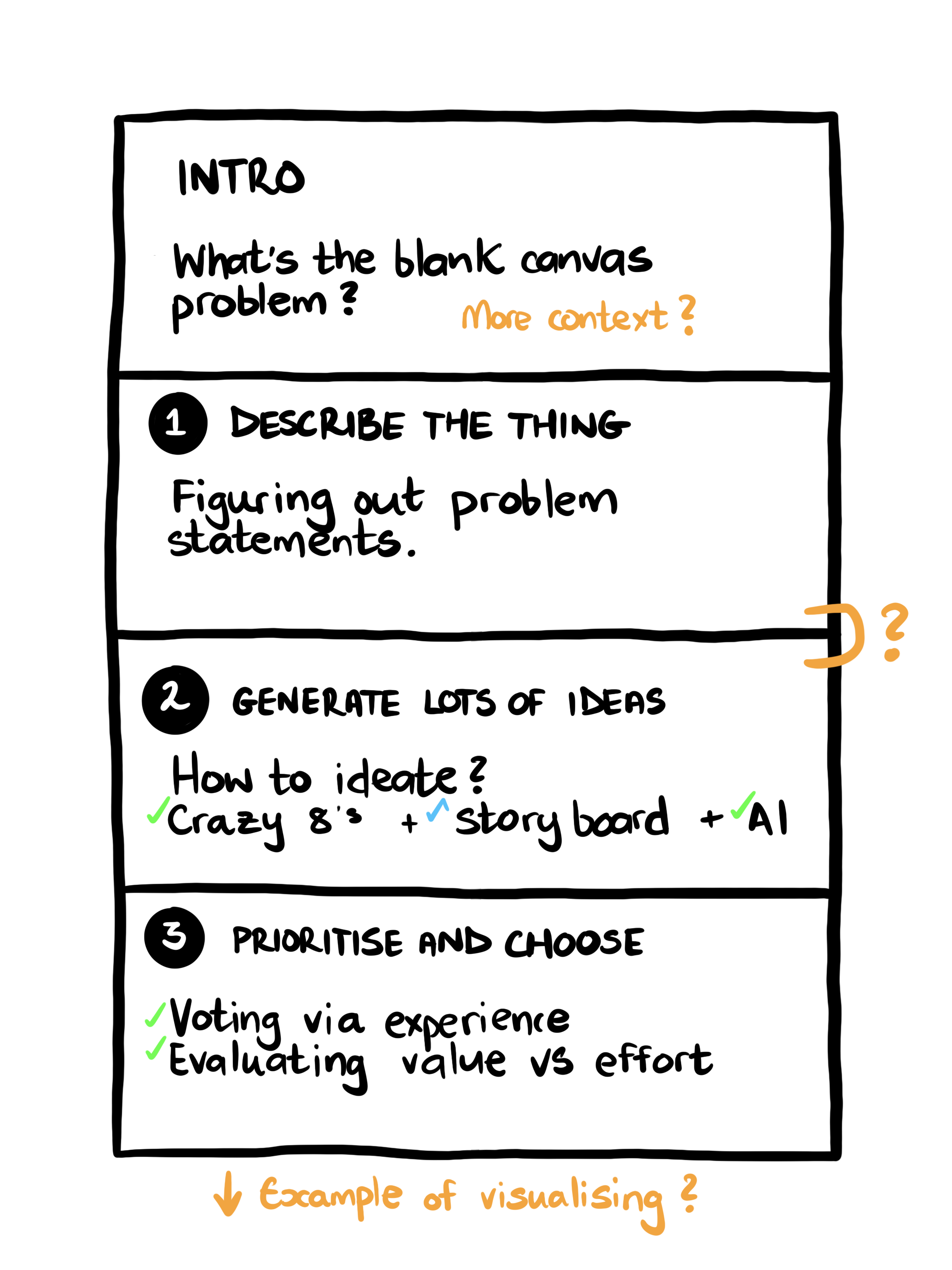
Generative AI
Our minds are powerful, but with an AI co-pilot, we can unlock thoughts and possibilities that we might not ever consider. Ask an AI for ideas, outlines, and concepts to consider related to the problem statement. It might be tempting to use AI generated ideas verbatim, but they're more useful when we interrogate, explore, and expand on them with our own experience and intuition. The highlighted areas in the ChatGPT thread below are interesting to me, and might deserve to be included in our ideation. Notice that they're sparse and overall quite abstract.
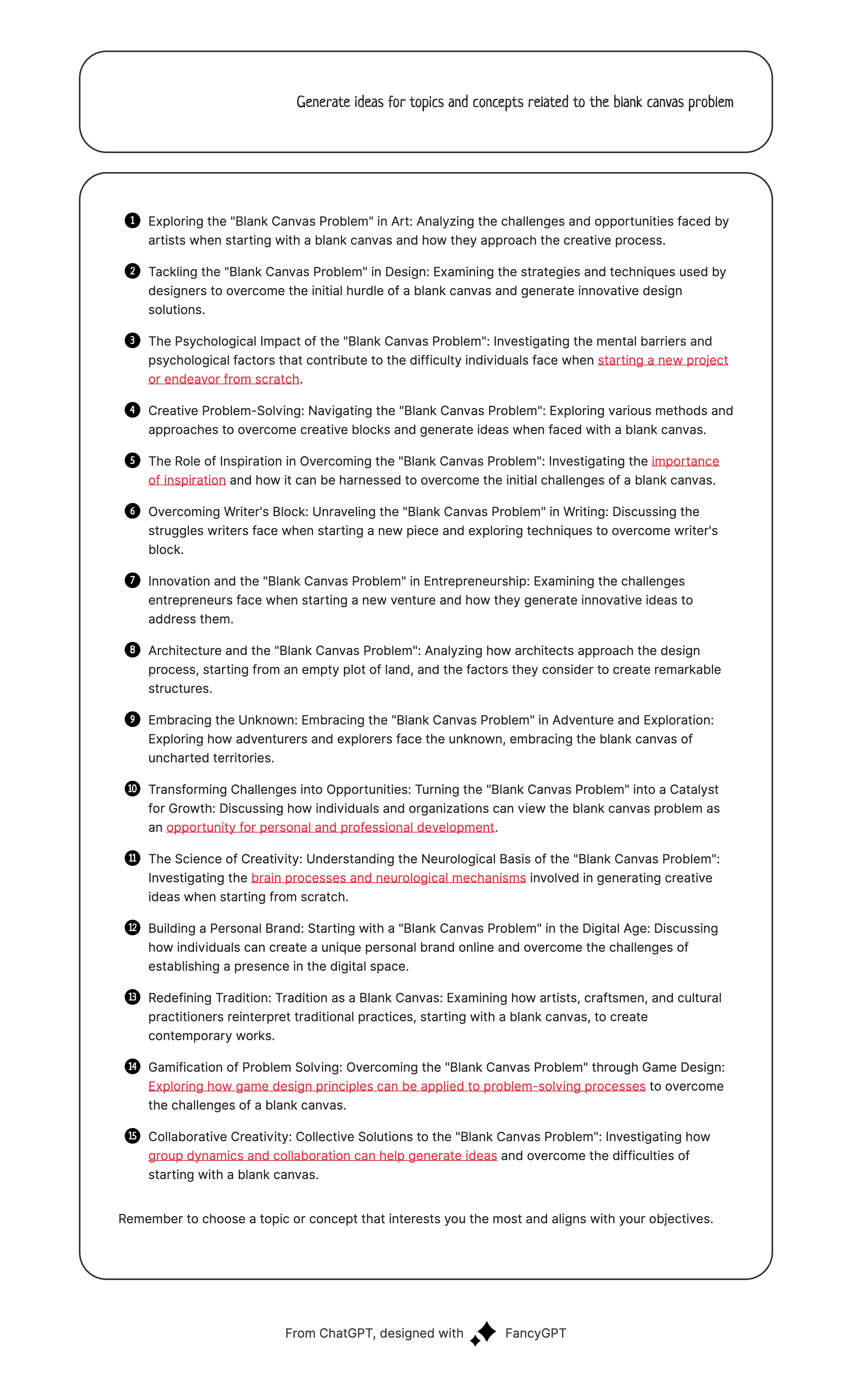
3. Prioritise & focus
The process of generating many ideas and possibilities is divergent thinking. It's great for exploring the breadth of a problem space and creating many options that might be stuck in our heads. But this results in many ideas, some good, some junk, some realistic, some impossible. That's where convergence is needed.
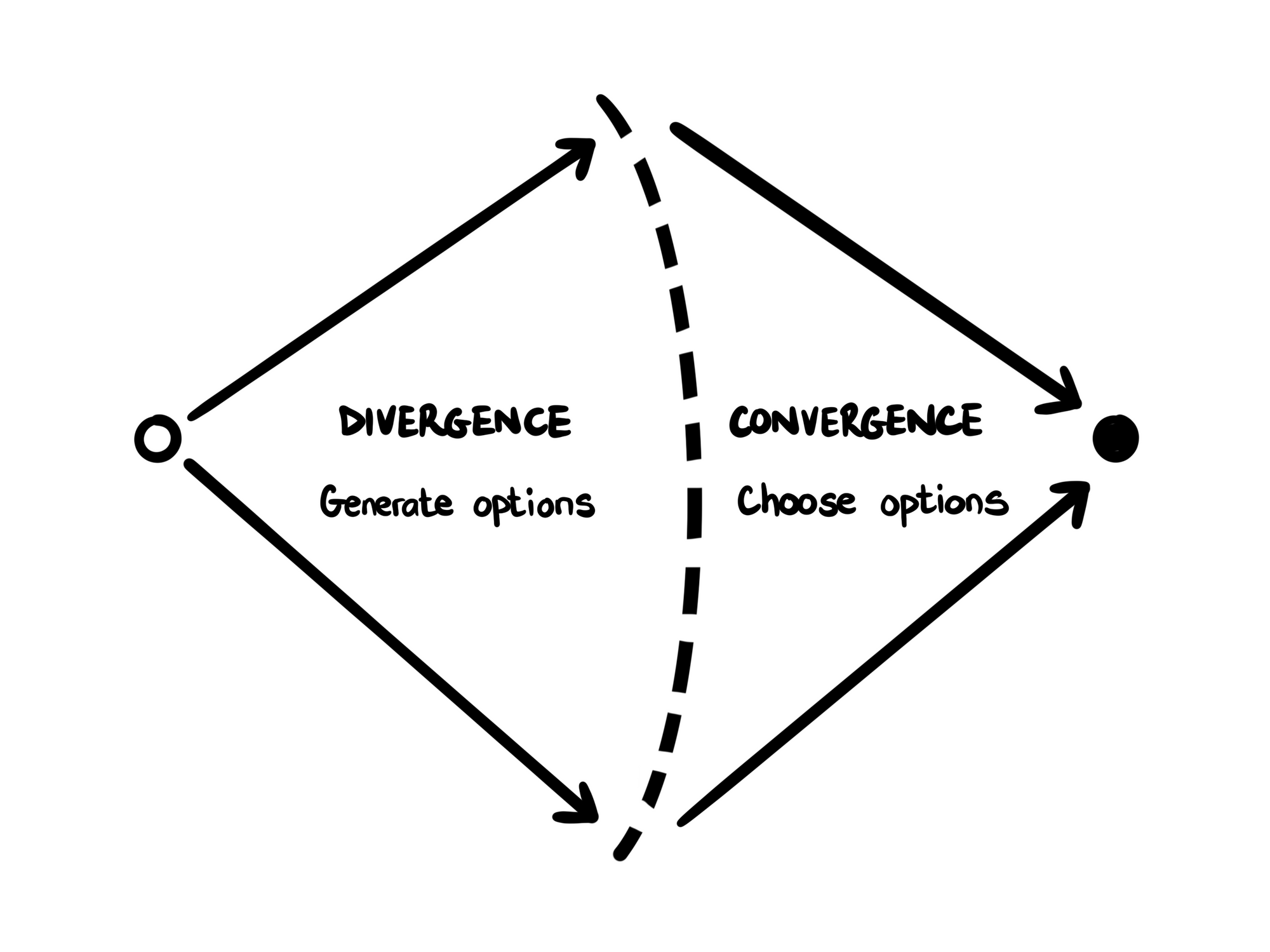
Voting
Whether you're doing this activity alone or with a group, voting is a great technique for withering down the list to it's most important ideas. With all the options in front of us, we might have a gut feel about the ones we don't like, from experience and intuition, or we might be tempted to pursue as many as possible. Constraining votes helps us pick what's vital. In the example below, I allowed only 4 of 8 ideas to be selected. In a group setting, we might give each person a single vote per set of ideas.
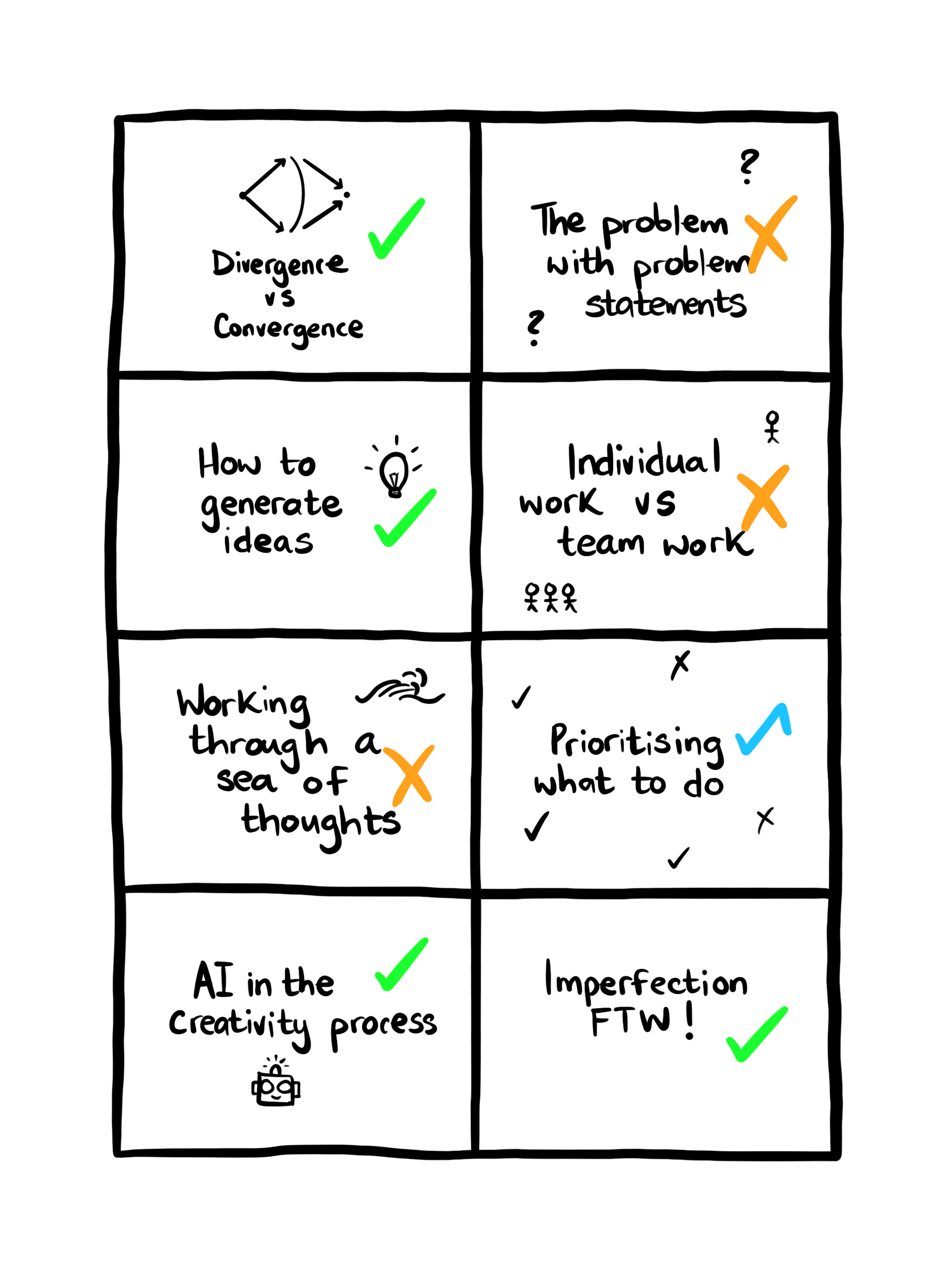
Prioritising
Another approach that can be used in conjunction to voting is prioritising. Without ruthlessly selecting a few options, we might be stuck in the opposite situation of the blank canvas - having too many ideas. Typically things can be rated by 1) how valuable they are, and 2) how difficult or complex they are to achieve. These measurements are typically guided by our own intuition, but supplementing that with a group's popular opinion often leads to more accuracy. Rank each idea's value, and how much effort or complexity it might have to see it through, then focus on the high value, low effort ones. Note: Although high value, low effort is good to get the ball rolling, high value, high effort is what makes groundbreaking thing happen.
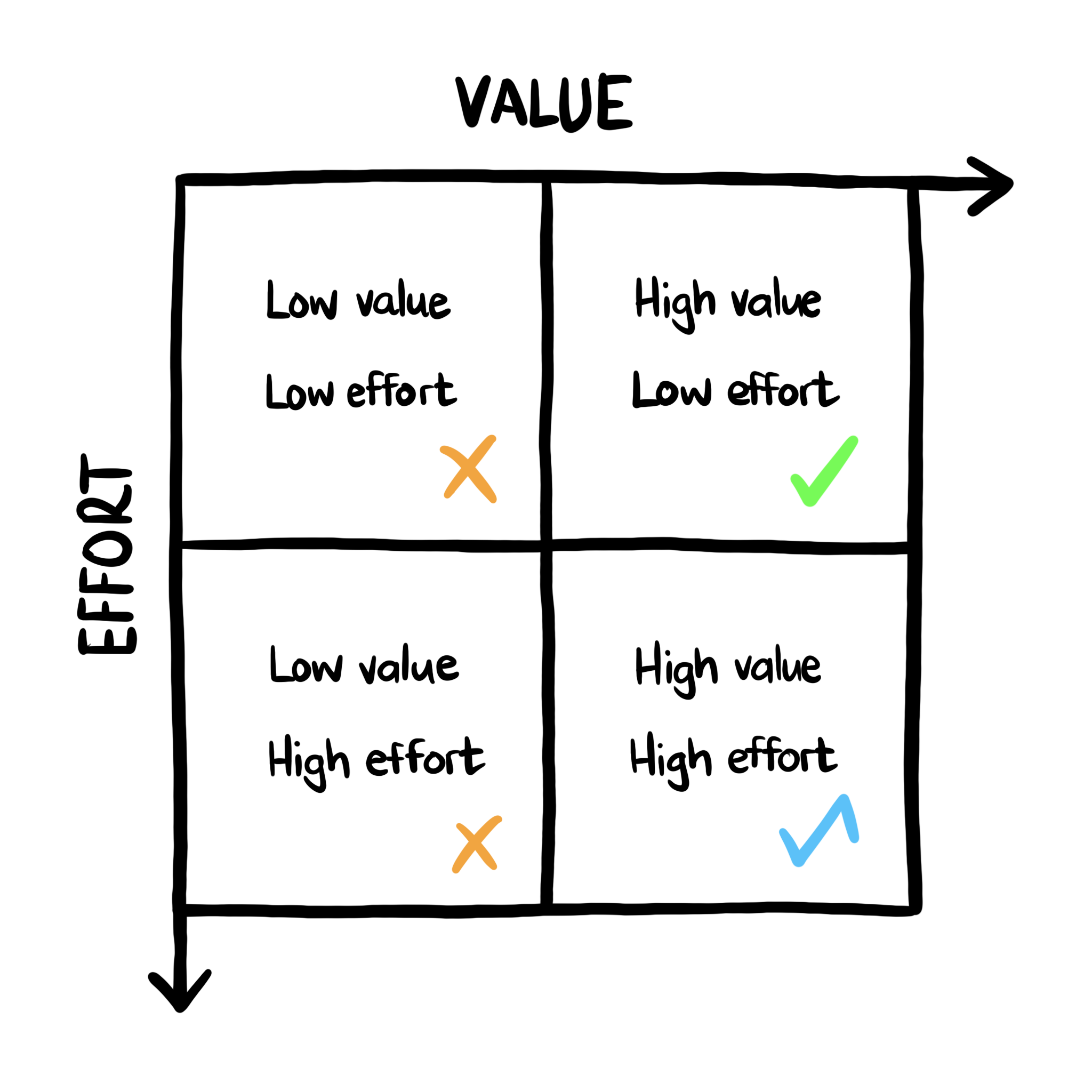
After voting and/or prioritising, we should be left with a list of the best concepts, and a foundation to expand on each, then materialise them into something useful in the real-world. With the examples that we explored, the final output is this very article that you're reading, along with the sketches and summary below.
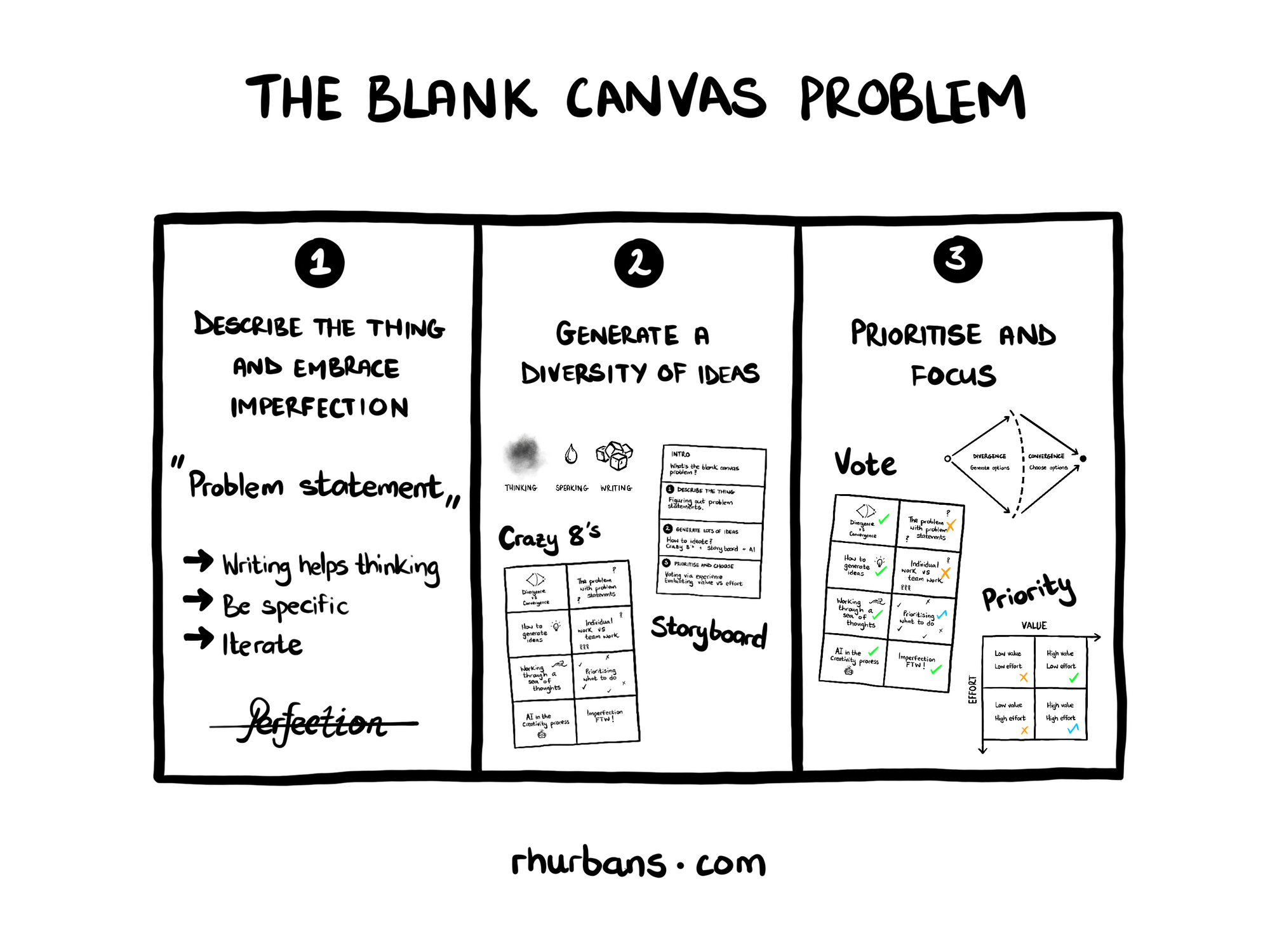
We've gone from a blank canvas, to a problem statement, to a vast variety of ideas, and narrowed it down to a solid concise way forward. Try this approach in your world, and adjust it as you need.
Interacts is a tool that makes remote and hybrid collaboration (like what we've just explored) easy to setup and run, and engaging for participants, with automatic reporting and actions for you and your team. Try it out here.
I hope you enjoyed this edition and was enriched by it! If you missed the previous edition, read about Storytelling.
We're building software that make people more productive and happy. I'd love it if you tried my projects, and I appreciate any feedback you may have, email me.
Interacts - Remote agile made easy
🧩 Interacts: A remote and hybrid collaboration tool for engaging workshops, retrospectives, team building and more.
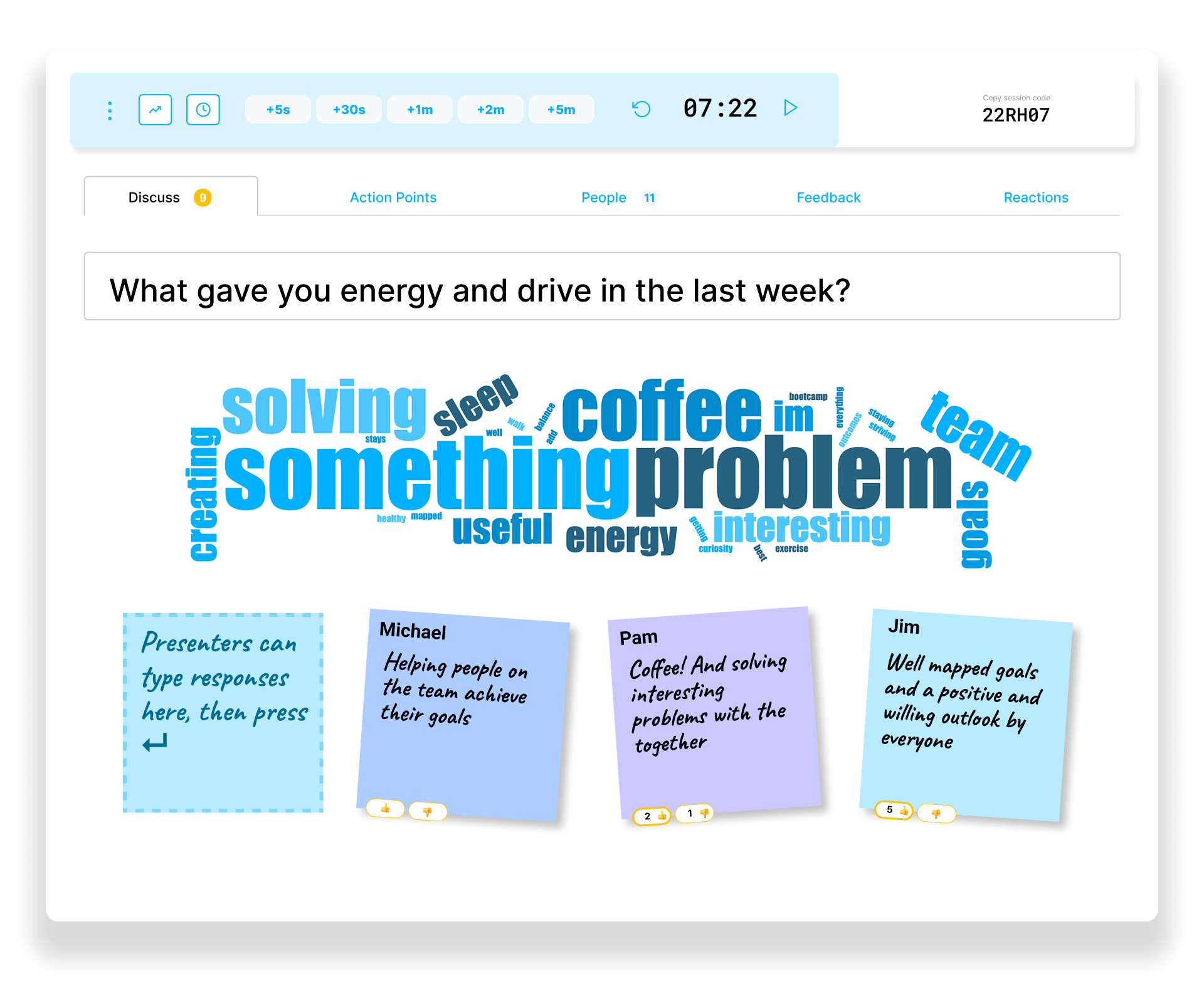
FancyGPT - Make ChatGPT threads fancy
🤖 FancyGPT: A Chrome extension to save and share beautiful ChatGPT snippets as images, searchable PDFs, and text files.
Share and stay in touch
If you enjoyed today's newsletter, please share it with your friends, family, and colleagues! Also, please "add to address book", it helps with email server delivery.
If this email was forwarded to you, consider subscribing to receive them in future.
Connect with me on LinkedIn
Processing your application
There was an error sending the email, please try again
